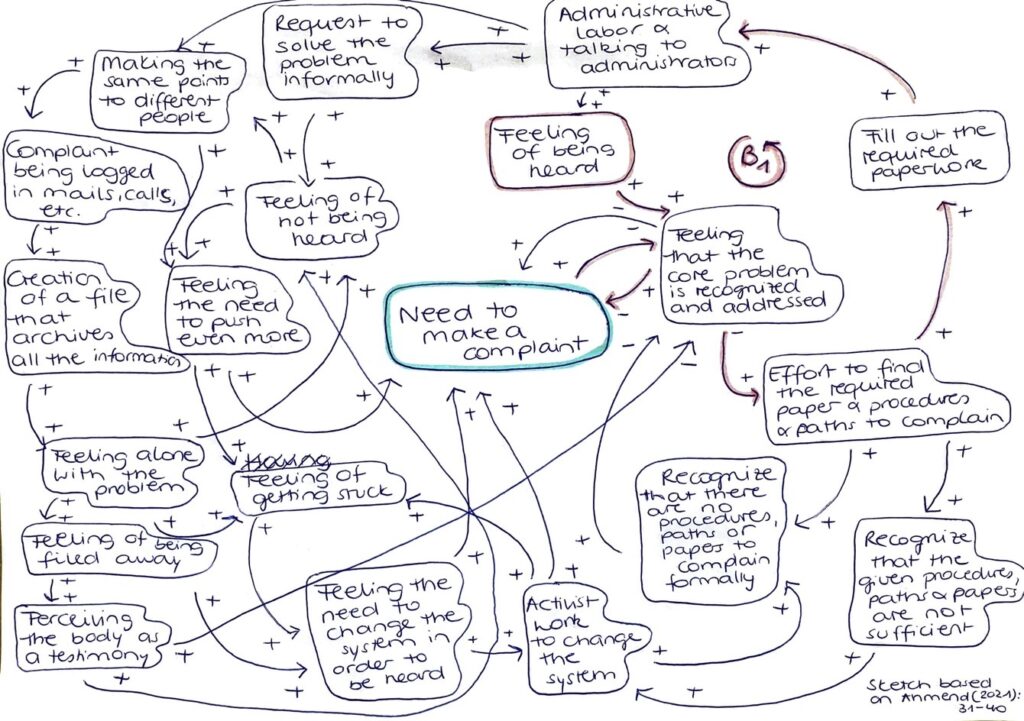In the passage “Following procedures”, Ahmed describes how complaint processes are often represented as flowcharts that show how a complaint is recorded, seriously investigated and addressed, whereas actually making a complaint feels circular, confusing and messy (cf. Ahmed 2021: 31-39). Explaining reasons that lead to being blocked, not being heard, or realizing that even the complaint process is discriminating, she illustrates how undergoing a complaint process regularly causes feelings of being filed away or functioning as a testimony and fosters the need to complain even more.
To illustrate how a supposedly linear complaint process actually turns out to be a confusing and confounding systemic cycle, I extracted the arguments made by Ahmed in the passage “Following procedures” and developed a Causal Loop Diagram based on them. Causal Loop Diagrams are a system-theoretical method that allows to capture complex systemic relationships. By connecting variables, which in this case are Ahmeds points made in “following procedures”, with each other and adding positive and negative polarities, cause and effect loops are obtained. The formed causal loops either have a balancing or reinforcing effect on the initial situation, with respect to the main variable of the system (cf. Mabin et al 2006: 37 ff). In this case, I chose the perceived need to make a complaint as the main variable (Ill. 1, blue variable).

Illustration 1: Systemic loops of complaint (Based on Ahmed 2021: 31-39)
Generally, Causal Loop Diagrams help to capture and understand complex interrelations and unveil underlying structures and motives of a system (cf. Mabin et al 2006: 37 ff). However, as shown in the illustration, the complaint process as explained by Sarah Ahmed, can not be mapped in a clear and understandable way, because it holds loops of systemic blockage, frustration and disorientation.
As Ahmed describes it:” What leads you to make a complaint is what makes it hard to complain” (Ahmed 2021: 35). Looking at the loops mapped in the illustration, it becomes clear that this feeling – being pressured to undergo a painful complaint procedure to complain about something painful that has happened to you – constantly reinforces the perceived need to make a complaint (Ill. 1). Just one loop seems to have a balancing effect on the feeling of having to complain: It is the feeling of being heard (Ill 1, pink loop). But although this might at first make the complainant feel like the core problem that caused the complaint is being recognized and addressed, it must be noted that this feeling does not necessarily mean that the needed actions to change something are really being performed. This rather frustrating finding, expressed in the illustrated “systemic loops of complaint” underlines the following quote from Sarah Ahmed:
“Complaints end up referring to complaints; you have to keep dealing with what is not being dealt with; yes, once you start the process, it is hard to get out”. (Ahmed 2021: 37).
References:
Ahmed, Sara. Complaint!, New York, USA: Duke University Press, 2021.
Gurule, Donna. Systems Thinking: Causal Loop Diagrams. 2018.
Retrieved from: https://www.youtube.com/watch?v=LgnBSdcxPD0.
Lannon, Colleen. Causal Loop Construction: The basics. n.d.
Retrieved from: https://thesystemsthinker.com/causal-loop-construction-the-basics/.
Mabin, Victoria J.; Davies, John; Cox, James F. International Transactions in Operational Research. Jan2006, Vol. 13 Issue 1, p33-57.